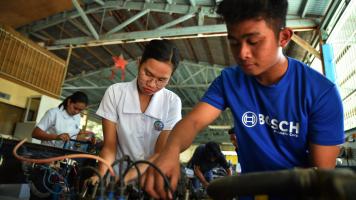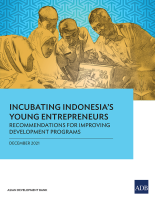To facilitate the school-to-work transition, the Philippines focused on education reforms and skills development, job creation, and labor market interventions. Photo credit: ADB.
In the Philippines, a multifaceted approach is easing the transition of disadvantaged youth from school to work.
There is a youth employment crisis in developing Asia. A mismatch between available jobs and skills is at the root of the problem. While there is no substitute for quality and relevant education, labor market activation programs also play a key role by helping the most vulnerable groups and providing targeted responses to market changes and disruptions.
In Southeast Asia, the Philippines pioneered a job placement program that assists at-risk young Filipinos through career coaching, life skills and technical training, and paid internships. Since 2014, JobStart Philippines has helped thousands of young people from ages 18 to 24 years old to secure gainful employment even during the COVID-19 pandemic.
JobStart is part of a package of reforms and interventions supported by ADB, which is designed to shorten the transition of young people from school to work. It includes improving public employment facilitation services, enhancing skills development and training systems, and strengthening labor market policies, including social protection for workers. ADB supports the government’s initiatives to promote youth employment through technical assistance and more than $1 billion in policy loans since 2017.
Neither in school nor working
In 2013, 25% of the youth population in the Philippines was not in employment, education, or training. ADB research showed that youth who are at risk of falling into this category included those who attained only a high school education or lower, women with low educational attainment or were rearing three or more children, and youth from poor households. It took high school graduates 4 to 8 years to find regular employment. They often ended up with low-paying jobs, with young women earning less than the men.
To facilitate the school-to-work transition, the government focused on education reforms and skills development, job creation, and labor market interventions. Key initiatives include extending basic education by 2 years, improving apprenticeship and dual training schemes, funding employer-led training programs, implementing JobStart and other labor market activation programs, and strengthening public employment service offices (PESOs).
ADB supported the design, pilot implementation, and expansion of JobStart, which has become a flagship program of the Department of Labor and Employment. After a successful pilot, the JobStart Philippines Act was signed in 2016, providing state funding for the program’s nationwide rollout.
Implemented by community-based PESOs, JobStart targets young people who are not in school, working, or training. They must have at least reached high school level to be eligible for the program.
JobStart partners with companies, funds training and internships, and provides a daily allowance to trainees and accident insurance during the 10-day life skills training. It helps young people to jump-start their career by equipping them with the skills necessary to meet the demands of a competitive labor market. They receive a certificate from the Department of Labor and Employment upon completion of the program. In the meantime, the program encourages employers to hire workers with no or less experience by subsidizing the cost of training and internship.
Mobility restrictions during the COVID-19 pandemic, however, affected program implementation. A digital platform called Youth Employment Exchange was created to enable online registration, link JobStart trainees with PESOs and employers, and continue training sessions online. JobStart became part of the government’s recovery efforts to boost employment, businesses, and the economy. The online platform also expanded the reach of the program to cover more remote and poorer areas.
Strengthening the labor market
ADB also supported policy development, regulatory reviews, and capacity development at PESOs, which serve as local governments’ frontline for employment information and services. Policy actions aimed at promoting youth employment and creating a healthy work environment included the following:
- strengthening the legal foundation for employment facilitation;
- aligning technical training with labor market demands and international standards;
- establishing an unemployment insurance scheme;
- improving workers’ protection;
- establishing Tulong Trabaho (Job Assistance) scholarship fund for selected technical and vocational education and training (TVET) courses;
- developing a national plan to promote green jobs; and
- waiving government fees and charges for more than 10 preemployment documents through the First-Time Jobseekers Assistance Act.
Improving employment opportunities continues to be a priority of the Philippines as it advances toward becoming an upper middle-income economy. While the share of youth not in employment, education, or training is down to 11% in April 2024 from the pandemic level of 25.2% in April 2020, youth unemployment is still high at 10.5% and underemployment, at 13.8%.
In its new country partnership strategy, ADB commits to helping the Philippines on human development. For the period 2024–2029, the strategy is to focus on providing Filipinos, particularly those from low-income households, with improved access to vocational training, technical skills development, and entrepreneurship programs.
Expanded support
Under a new ADB-supported program, the government is pursuing reforms and initiatives to prepare Filipino workers for “higher-skilled jobs, such as in analytics and artificial intelligence, software development and security, and business process management.” It is targeting an increase in formal employment in the private sector by an average of 600,000 to 700,000 jobs per year.
Supported by a $500-million policy-based loan, the program covers vulnerable youth and targets increased participation of women in the workforce through TVET. It builds on ongoing school-to-work transition schemes and complements a project that is helping upgrade and modernize TVET training institutes managed by the government’s Technical Education and Skills Development Authority.
The government wants to raise the number of job placements through PESOs across the country by 120,000 annually and expand the number of local government units implementing the JobStart program.
According to the Department of Labor and Employment, 2.7 million people found local and overseas employment through PESOs in 2024, while 32,000 job seekers were trained nationwide.


